Revolutions are a messy business, often best talked about over the dinner table than actually conducted in all their randomness and unintended consequences. Often, the best kind of revolutionary acts are the quiet ones, the swapping of philosophies due to the incoming paradigm just making more sense. And we’d venture to say there’s something of that shift happening in the workshop at Predn Surf founded by Peter Clemo, scion of a long line of boat builders.
You can catch Predn at the Blue Earth Summit, happening in Bristol on Oct 11 to 13. Grab a ticket here. But before that, we caught up with Pete to find out a little more about how Predn came to life.
Building a sustainable shaping biz in deepest Cornwall is a bold move. Can you let us know why you set up PREDN Surf?
The seed of it came from a day of chat over a pint and a moment surfing with a friend. We had been talking about the surf industry and how harmful it was in absolutely every way. With every product, down to the wax. And the obvious irony of the whole scenario. It was the first time we had made the connection between surfing and damaging industries. And this was probably only around 2015, which I think was pretty late. Considering that we had always been interested in sustainability, materials and the way things are made, and always surfed.
We felt cheated and foolish for falling for the lie of what surfing pretended to be. That evening, we surfed. It was one of those lush, warm evenings with 2-3ft sets coming every few mins. So loads of time to chat in between waves. Between sets, while we were speaking (about something else) another guy joined in. He started to talk about the beauty of surfing and how awesome it is to be so connected to nature blah blah. We both looked at each other, remembering the conversation we had had earlier and pissed ourselves laughing! Then, we instantly felt bad and had to explain the whole conversation and why we were giggling like school kids. Probably ruined his night .But it really opened up a river of thought in my head and over the years, I kept having different board construction ideas. Whilst ruining all the new ones I was buying.
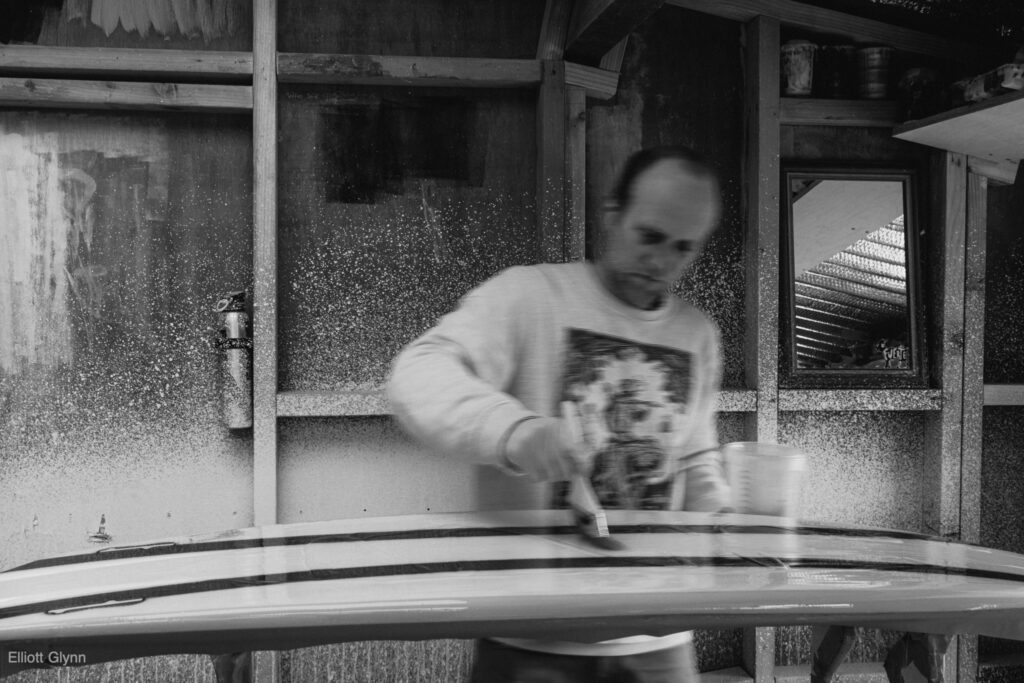
A couple of years later, I ended up with a summer off and the use of my best friend’s workshop to do what I wanted. I had these ideas and wanted to make a board. Ended up making eight that summer. I didn’t set out to start a shaping biz. The company itself happened quite organically. I just wanted to play around making some boards, really. I knew there was a better way to build them, both more sustainably and just better quality. I wasn’t just sure of the formula straight away… At first, I started out on what I realise now was the wrong path. I looked at hollow wooden construction for the answers. These boards are great fun to build and can potentially (if well built and maintained) last forever, not to mention how lovely they can look. But after building and riding a few, I quickly realised they didn’t have the performance values most surfers look for in a board. Stiff, unforgiving logs, really and often not made from great wood.
I then started experimenting with other methods. A board with good (potentially controllable) flex and with the potential to last for years without loss of performance was the only thing I could settle for. Something I want to ride all the time. So Predn was pretty much born from that. The experimental boards that were built mostly got sold, so I kept going. Didn’t even realise what I was on to at first. Normally, when you think you’ve had an idea, loads of people have already done it. But it seemed most of the world was as slow to catch on as I was. I was in Italy working on a boat when the first lockdown happened. Work stopped, the world went crazy and weird, and I spent seven odd weeks trying to stay sane in an apartment in Italy, coming up with all sorts of ideas for new board constructions. I already had the workshop set up at home, so I could not wait to get back to try everything out.
Tim joined in at this point, and from then on we had it nailed. The ideas of combinations of flax and wood veneers we had during the lockdown were working a treat on EPS cores. Tim getting involved changed things massively. He’s a very clever young chap who understands engineering, math and computers! Tim and I had been friends for years already and worked on boats and some other random composite jobs together. But always had amazing conversations about new inventions and ways to build stuff and also just stuff to build. But we never shut up. Still now. To the point, It pisses people off. We had already come up with loads of board and surf product ideas. So it was only natural he got involved properly.
After Tim, Laura (Frenchie) became the third member. Laura had an amazing attention to detail from the offset and learnt the techniques super quick. At that point, we also all lived in a field together in caravans; we had the workshop to play and started making boards and cool stuff and just living the dream, really. Surfing when there was any swell and making boards in between. The boards were improving all the time and slowly began to sell. We were getting some good attention and started to realise not many others were actually doing this kind of thing.
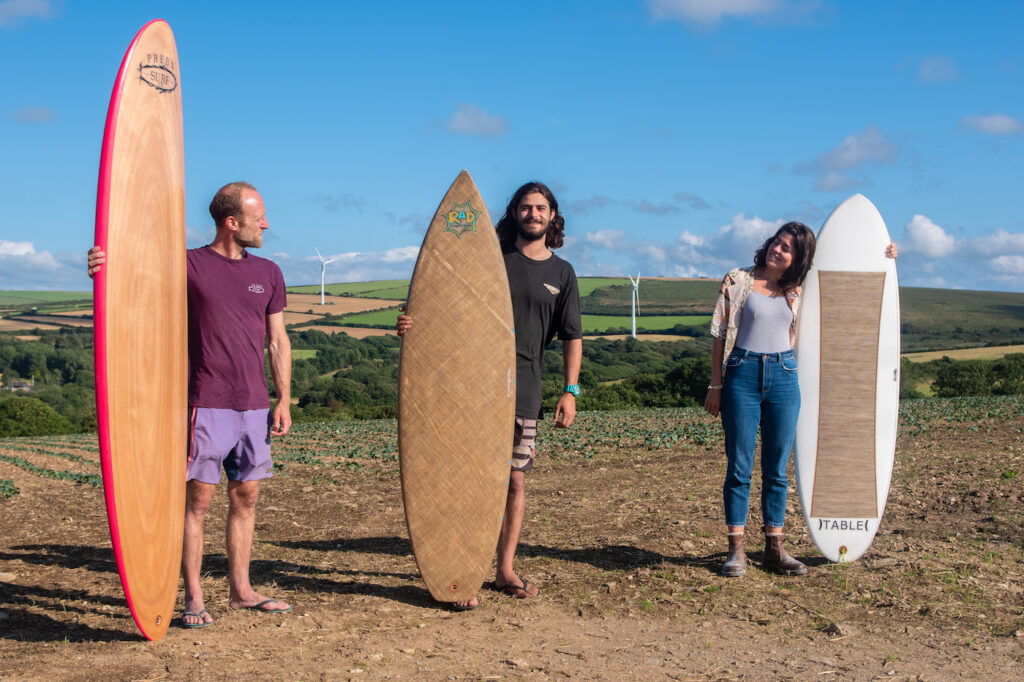
And what was your background before this?
I grew up in St Austell. Schooled at Mt Charles, then Poltair. Afterwards, I went to Falmouth Marine School and studied boatbuilding. Ended up specialising in building carbon fibre sailing racing yachts. But have spent some time doing all sorts of carpentry and furniture making. Always made random stuff. I just like to keep busy. When I was younger, I mainly bodyboarded as most of us South Coasters did. But then I moved to the North Coast pretty young, then grew up and started surfing.
Can you tell us a little about your manufacturing philosophy?
We think the most important thing is that a surfboard gets used for as long as possible, has zero loss of performance (if anything gain), and is easily repairable.It must be made from a balance of the highest quality yet most sustainable materials available and must also be easily recycled or reused if needs be. A board shouldn’t get worse as it ages. It should get better! Break it in almost, like a guitar. Our workshop is 100% wind-powered. We reuse and recycle everything we can and find ways to use offcuts. Minimise the use of consumables, and we are developing ways to be actually zero waste. Constantly making little tweaks and adjustments to our processes, which either improve the board itself or the sustainability of the build. Any time we find a material that can improve on the eco aspect of our boards and not compromise the performance or longevity, it gets used.
We are just now replacing the EPS cores with a bio version, which actually happens to be better than EPS, so our boards are almost completely crude oil free now. We are just now starting to make production models and are finding that it’s much easier for us to keep things lower ecological damage as we are starting from scratch with new, cleaner, less wasteful methods, and no bad practices. So when we do slowly scale up, sustainability will be built into our processes from the offset.
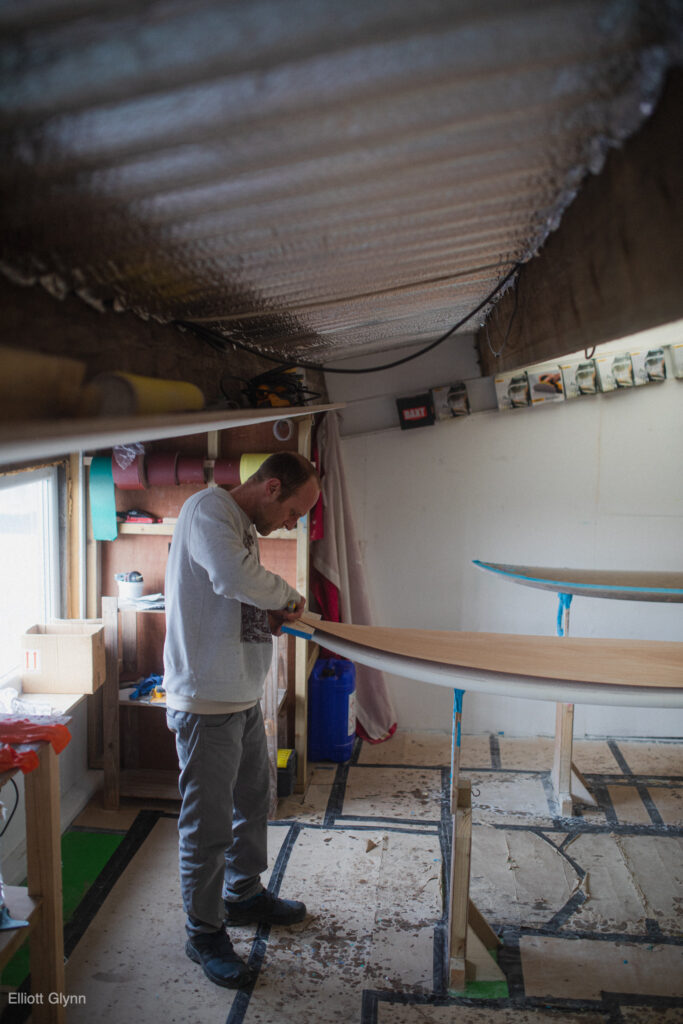
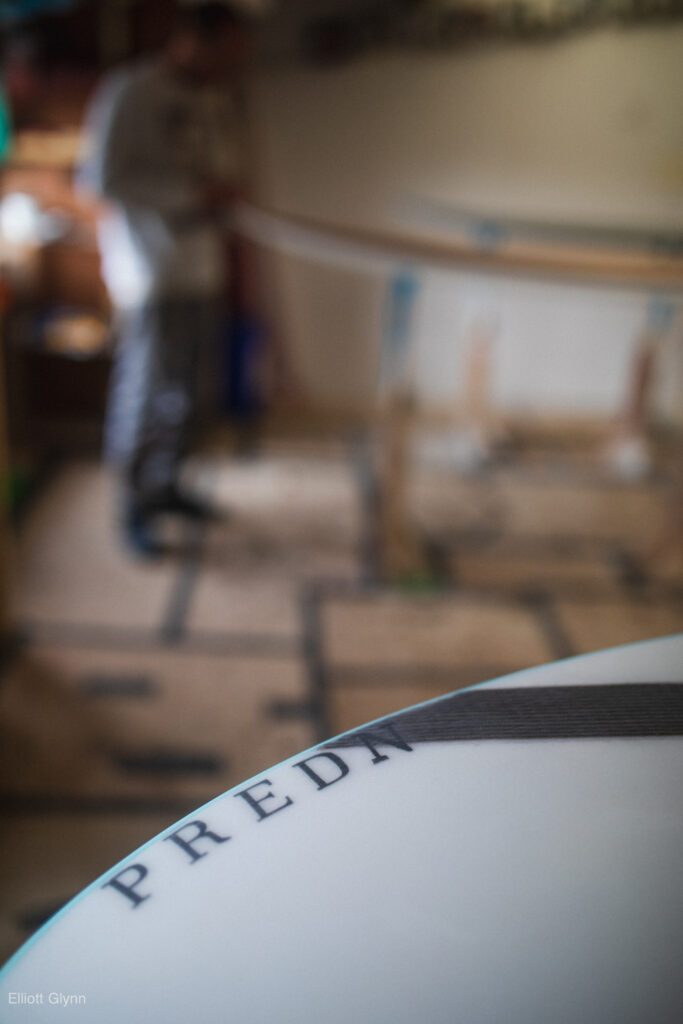
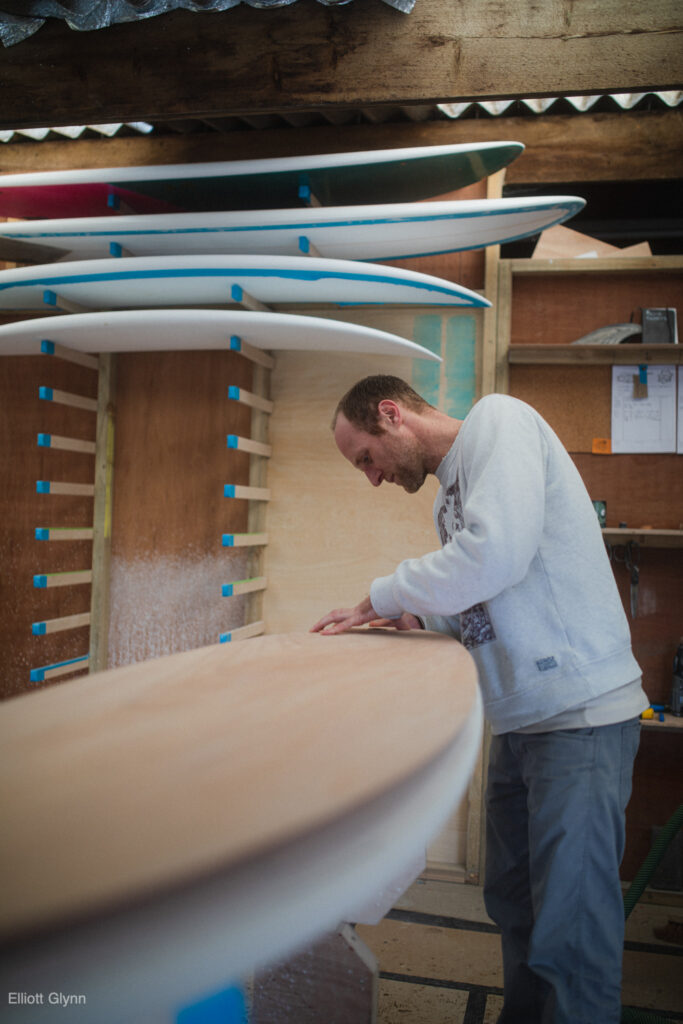
Can you tell us what are the main problems you are you trying to solve?
Surfboard manufacturing technology has been years behind pretty much all other composite industries forever. In fact, it has pretty much been stuck in the same stagnant stage for about 50 years. This is mainly due to the cheaper price tag of the old resins and blanks, etc, the ease of use of it and the speed at which a board can be produced. Epoxy is much stronger in every way; therefore harder to sand and finish each layer, thus taking longer to build each board. It can also be hard to convince the shapers that have been doing this for years to move to another product.
No old-timer likes having to change or relearn their processes. A fair few who have made the change to epoxy are using it incorrectly… Not properly going through the processes to bond the layers together and other time-saving tricks. This is just giving epoxy a bad name again. Some of these boards have eco-labels too. We repair boards. We see it all. Most are built very badly. Epoxy also got a bad name when it first hit the market because it was mega-toxic and had super high VOCs. Lots of people reacted badly to it, and it was yellow and gross. But now it’s actually much safer than any of the other resins.
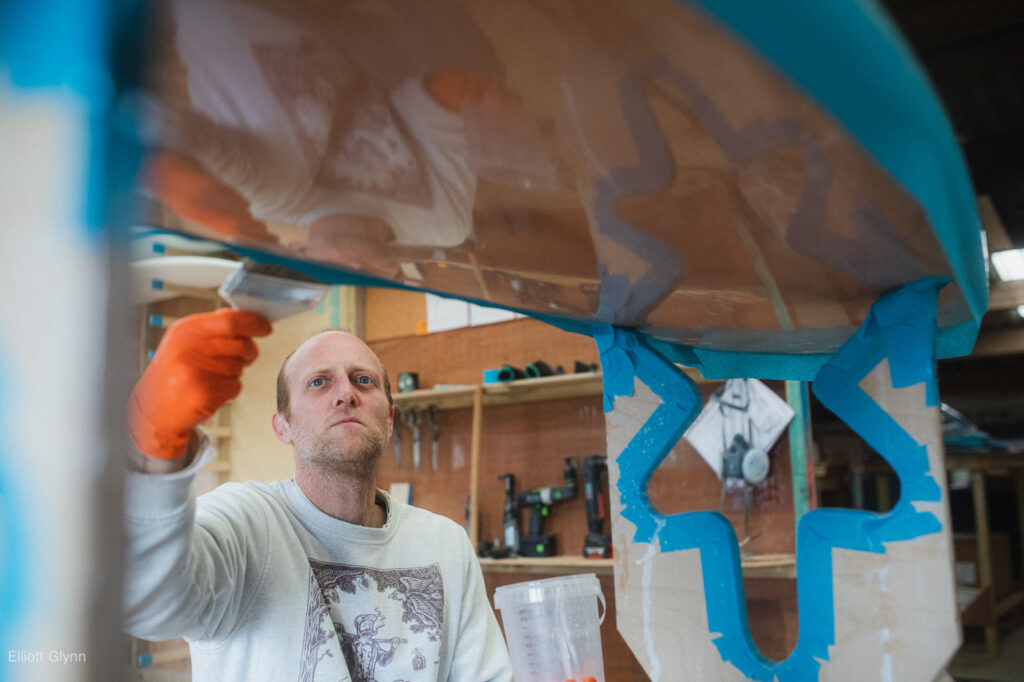
Surfboard manufacturing has actually played a huge part in these developments. There aren’t many other trades that leave such large coverings of resin going off in open rooms, de-gassing next to where you are standing and working. So something had to be done. The potential of the product was known, but the formula wasn’t right. However, now, with some awesome chemical companies like Resin Research making epoxy clearer, stronger, easier to use, low reaction and now with stupidly high bio content. Most of which is even food-safe once solidified. Epoxy is now clearly the best option.
The main problem out there is that people are spending crazy amounts of money on really badly made boards. These boards are mass-produced in a factory in terrible conditions for the workers. Often it is the wrong board for the customer anyway, and it ends up on FB marketplace. So, as always, education is key. It’s important that people know the quality difference in quality between boards. Besides, why would you not want to be able to pop it back to the person who made it if/when something happens? The big brands probably never admit when there is a quality problem with the board, and its really hard to prove. It’s only when we have to pull them apart to repair them we see how they are made.
A lot of what you see is just shocking! The main solution, as always, is education. By this, I mean marketing and branding. Sustainable just needs to be cool. It’s pretty much a whole sea change from what is cool at the moment. But this will never happen unless the products you are replacing the old with aren’t as good or better. So, we are finding solutions to replace the old with something much better and much more sustainable at the same time. Another big problem is quantity. The world doesn’t need to produce the number of boards it does a year. Or of most things for that matter. But if we just build less higher-quality boards, everybody wins. Even the manufacturers. And the world is going that way.
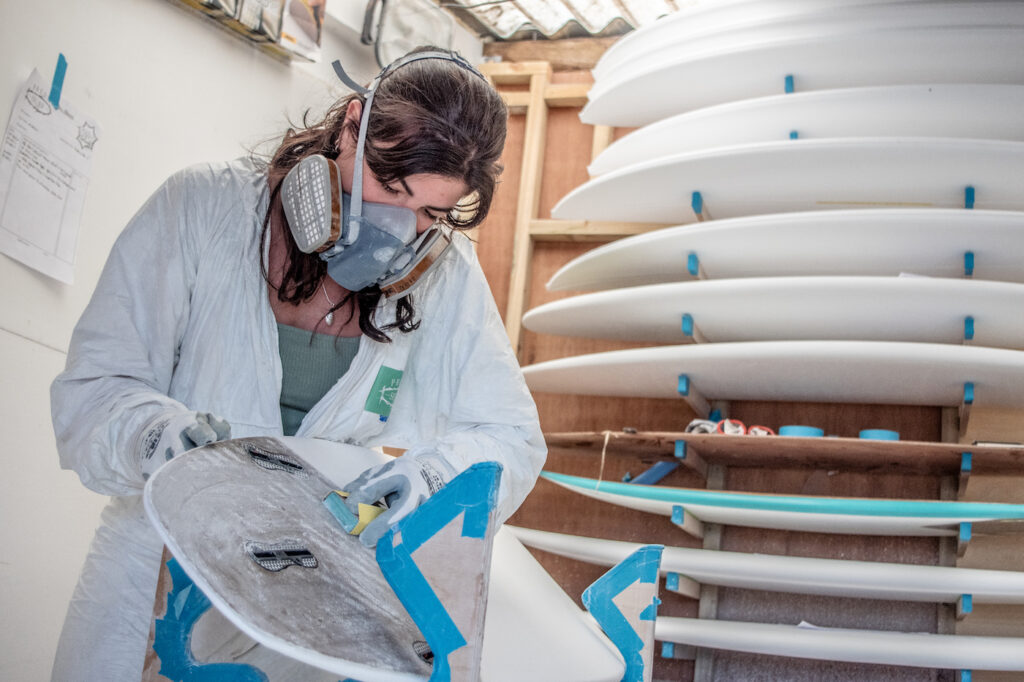
Tell us about your favourite materials to work with and what you would like to see more of in surf?
We love combinations of materials. Wood and flax work amazingly together. Would love to see more basalt fibres played with and made more available. Glass could probably be made in a more sustainable way; however, we haven’t found a better alternative to it yet, and no one has for a very long time, and we use much less than most boards. We are now moving onto a biomass blank EPS alternative with similar/better properties and I’m looking forward to playing around with that some more.
I don’t think too much of carbon fibre for a surfboard; it’s too stiff. Maybe for fin boxes or something where it does need to be as stiff and strong as possible, but use less of it than another material. I would love to see more wood veneers used. They are not just beautiful; they can be used in awesome structural ways to build amazing structures.
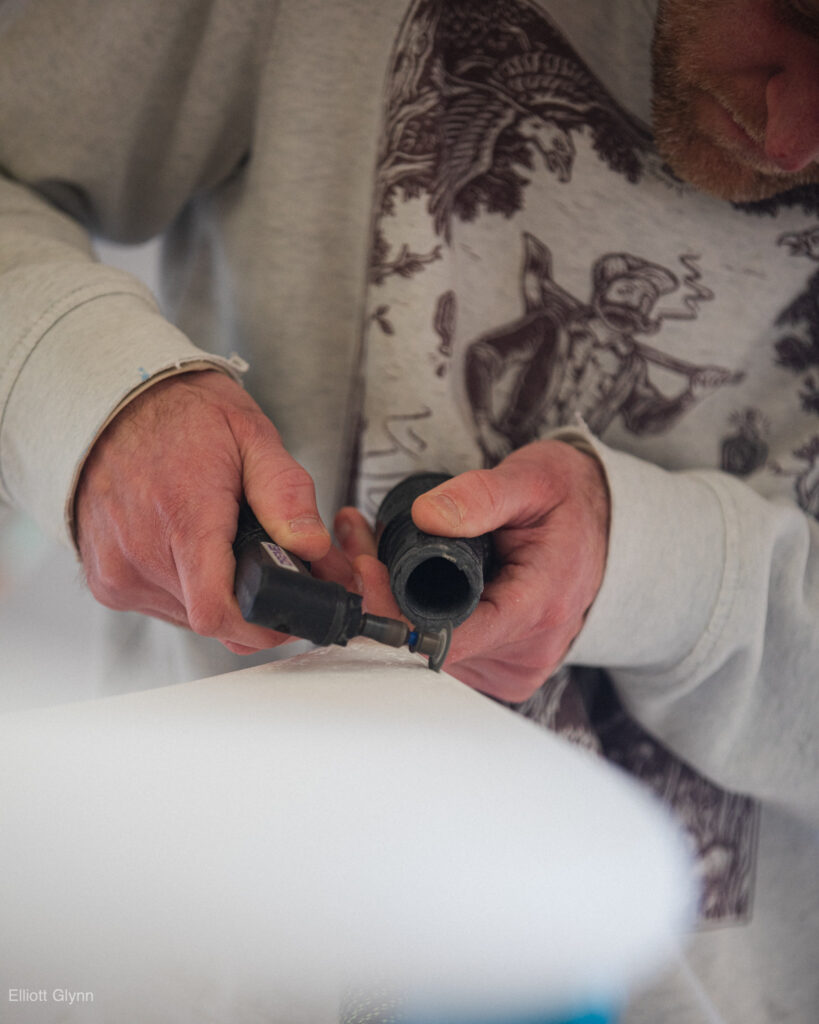
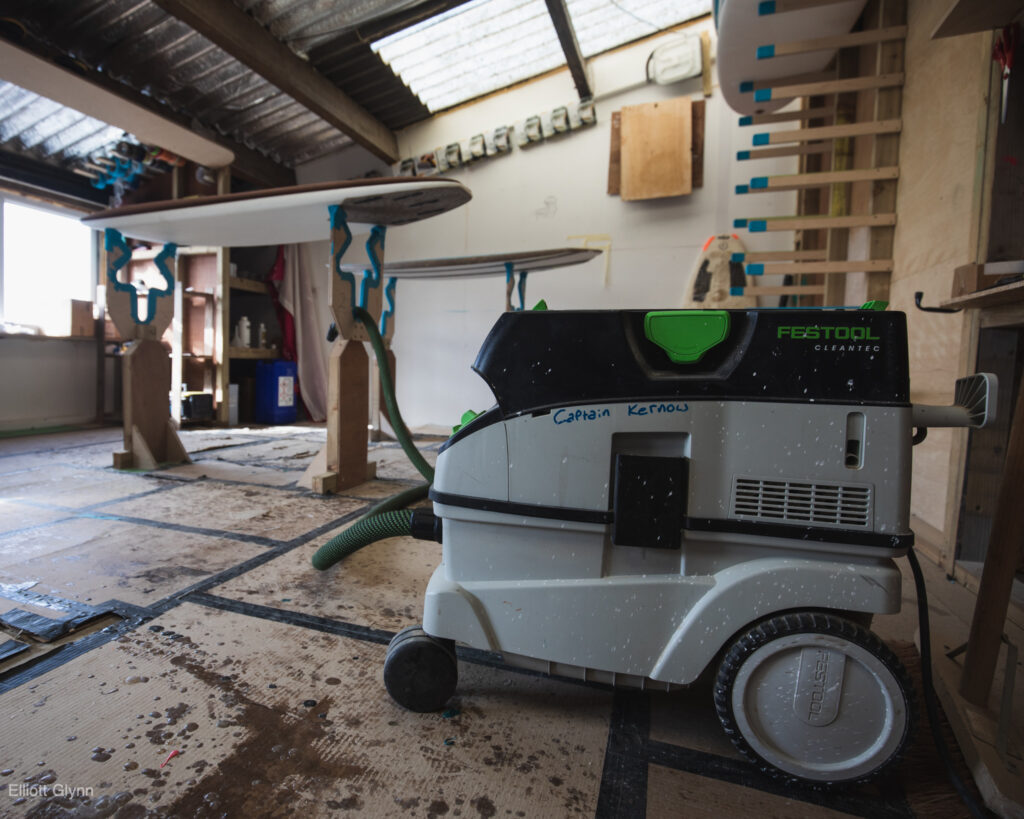
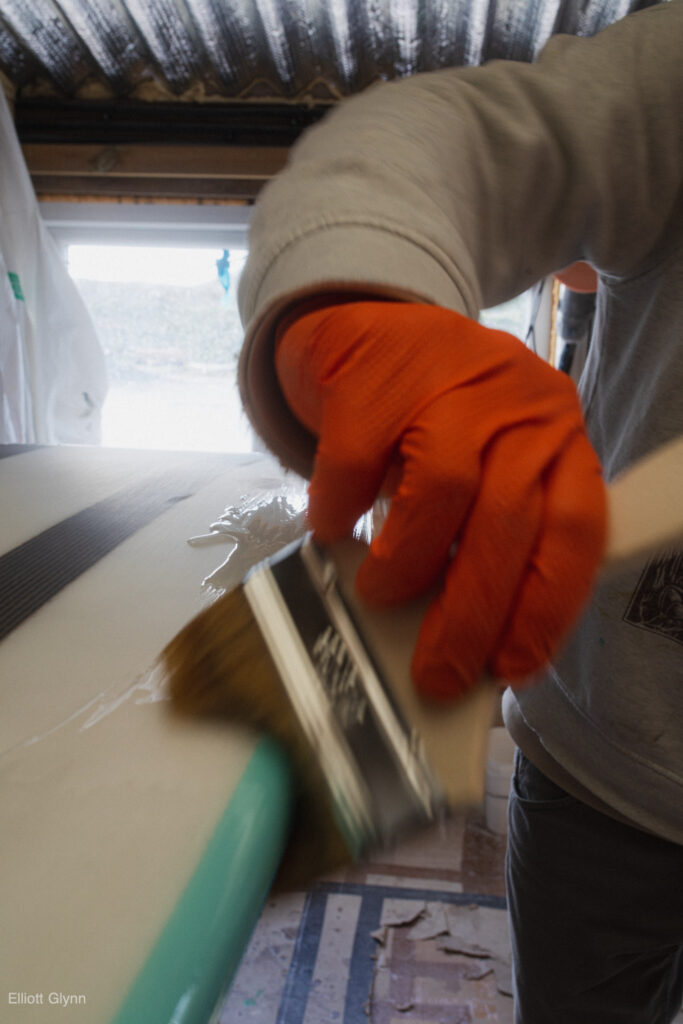
What models are you working on, and what shapes do you feel work the best for your way of creating?
At the moment, we are developing an oak-veneered deck board which needs no wax. It gets grippier when it’s wet! Obviously, you can wax it if you want to but bare foot testing has gone really well. It is being tested on a shortboard, too, so max grip is needed… But feels so good under your feet, and the wax problem is no more! I’m just figuring out the production process for them now. We will also be going into production with a range of eco-cork foamies which are awesome. And a bio bodyboard in the next few years where we will look to replace the cheap polystyrene ones with this. Some cool developments coming.
As far as shapes go, we pretty much get to make all shapes and sizes of board. Even a few SUPS [sad face]. Until now, we have mainly made customs for people who have had some amazing ideas, but it’s been the boards for ourselves we have really played with. The first bare oak board was for me, and it was a total experiment. It’s been amazing building different types of boards for people. Really gives you an understanding of how the same materials work in bigger and smaller situations. Our methods have to change slightly for bigger and smaller boards. So it’s great to be able to cater for everyone.
And what are the major hurdles you face in the manufacturing process in terms of materials which you can’t find ecologically sound replacements for?
All we can really do is use what is the most suitable and available to us. There are all sorts of new materials being invented all the time. But it takes so long for anything to become available. The blank foam I mentioned before, we have been waiting for, for a long time, to be actually available. It normally takes a while for brand-new groundbreaking products to go into production and become readily available. Not being able to access the materials you know exist, but you can’t get hold of has been a little frustrating at times. Overall, we are pretty much there with the ingredients, but there will obviously always be room for improvement. A waterproof and fully biodegradable resin after a sensible amount of time in the sea would be good.
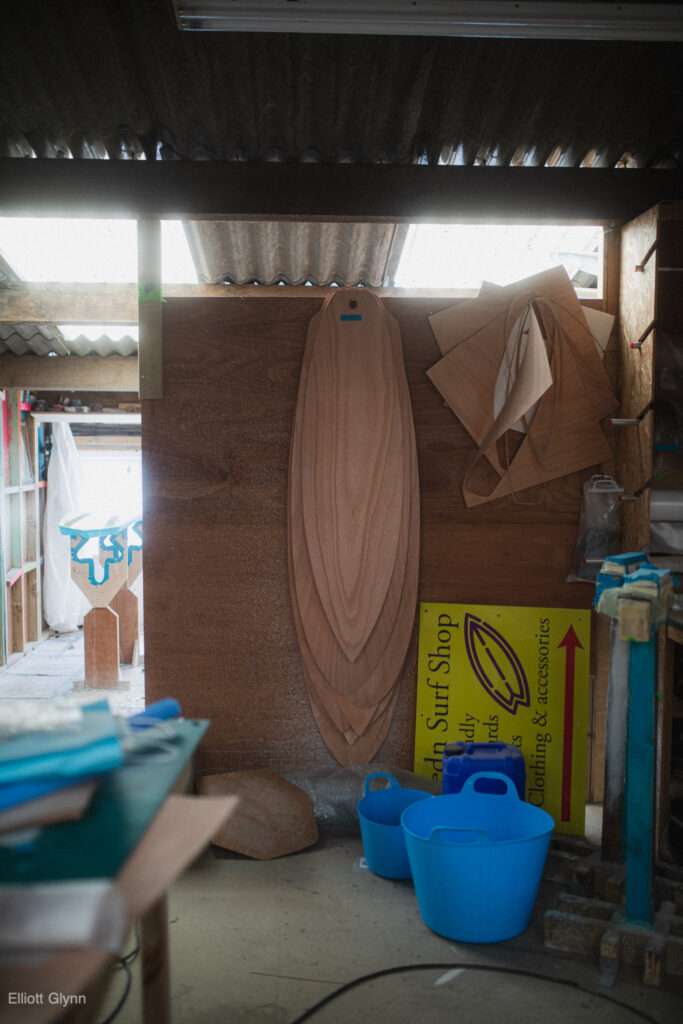
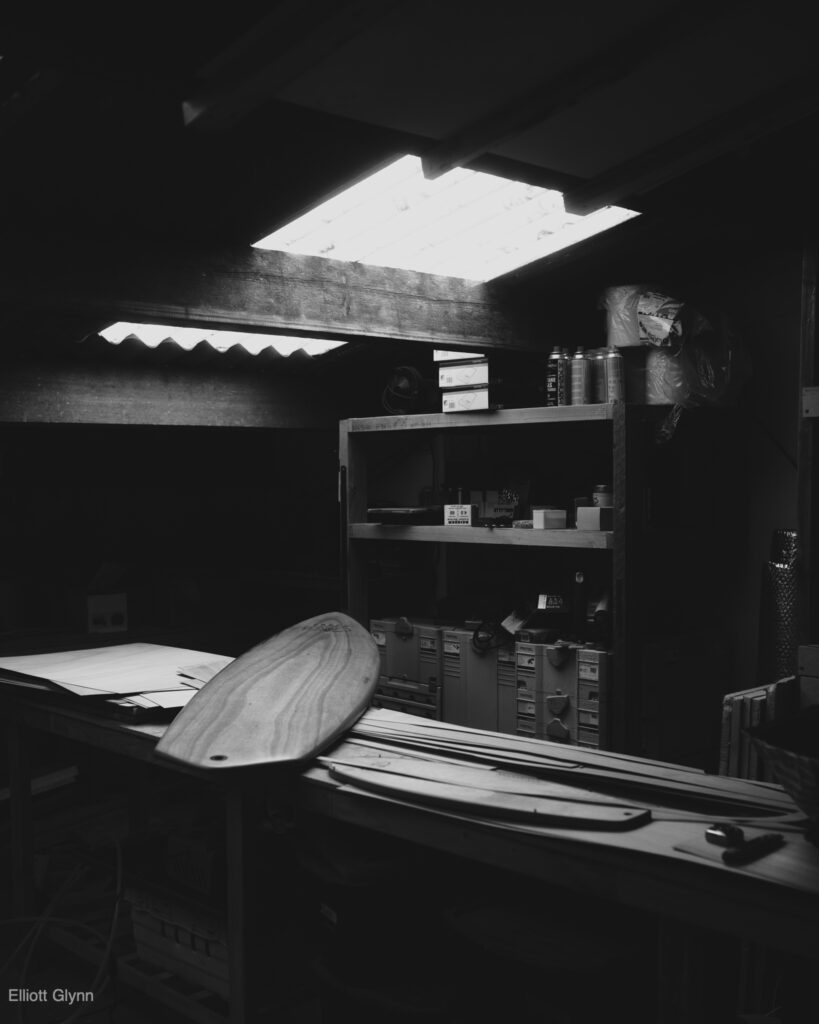
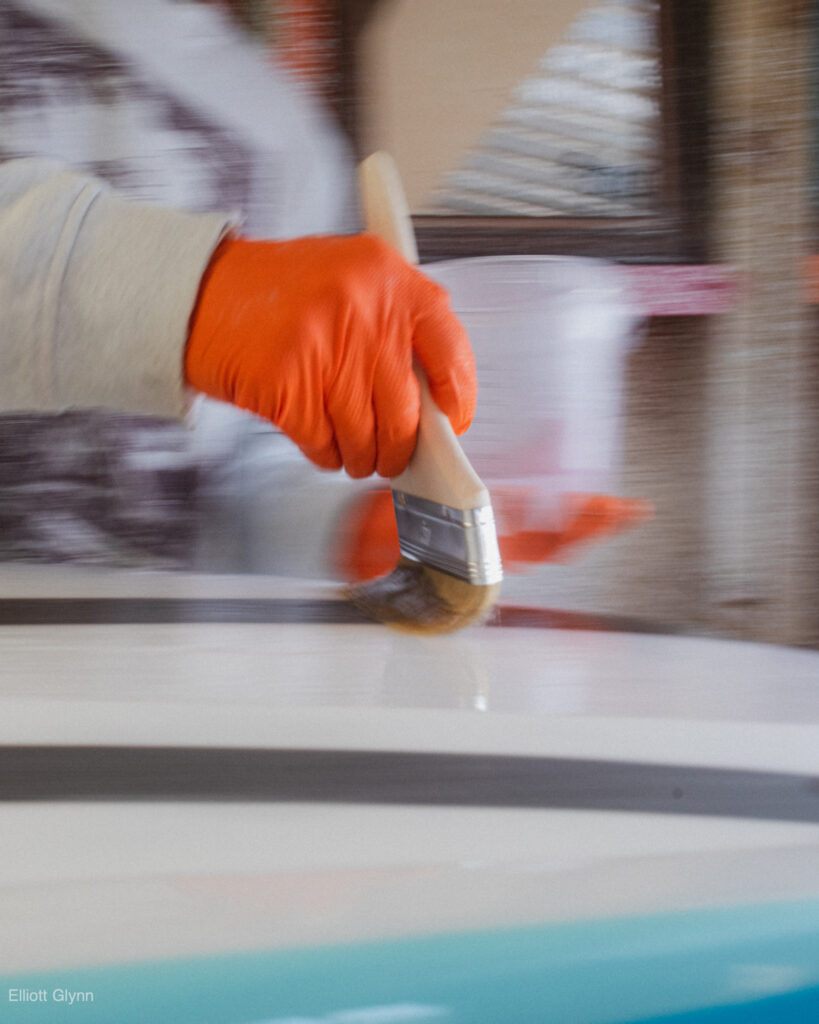
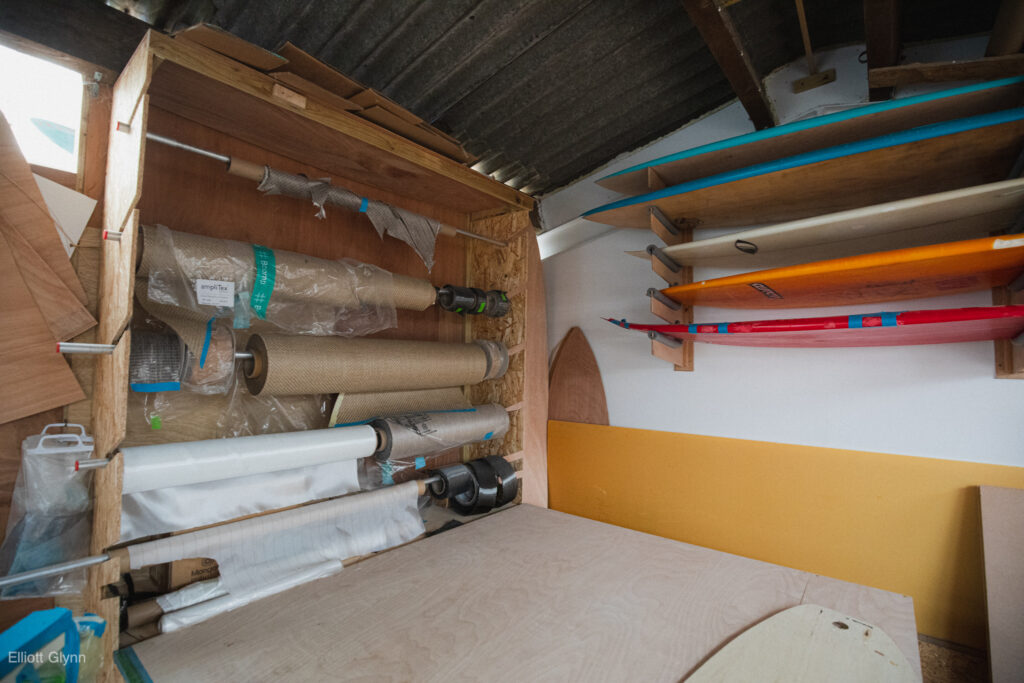
Ok brilliant. Do you feel sustainability in surfboard production like ‘eco boards’ is a step on a journey or an exercise in greenwash? Is a board with 25% bio-resin a stepping-stone to 100% circularity or lip service to the climate and waste crisis? Personally, I suspect it could be both. If manufacturers rest at just-about-good-enough, then it will always stay in the margins, but if they pressure the resin makers and the resin makers do the R&D, things might happen. What’s your view?
So far it’s a complete joke. There are so many opinions as to what eco or sustainable means, with much room for manipulation. But I think it’s important that we create a culture where we don’t just care who endorses it, but also how, where and what it’s made from and trying to keep it local if possible. Companies should have to be 100% transparent as to why their product is ‘eco’. Nothing is ever perfect, but we need to be honest about what we think is bad and find solutions. People plaster the ‘eco’ buzzwords all over everything to sell more at a higher price and this should be controlled.
There are now organisations policing sustainability for products, and you can bear their mark for a small fee. Although this is a start and means awareness is growing, I do feel this system, the system, needs a bit of a shake-up, which i’m sure will happen at some point. Big companies turning green from not being green at all is very difficult. Shareholders lose money when they make big changes that inevitably cost money to start with. Teaching all the new systems is difficult and expensive. They need to change everything! But they will probably need to be forced. Not to mention, we are asking them to produce less! I think it’s important that media companies make the first move and take the first hit. The media decides what’s cool and what sells. If you are reading this, the media has some form of control over you whether you choose to admit it or not.
The companies don’t really have the power, but the media obviously likes the ad payments which come from the big companies. Make the good companies big, then they can pay loads. There is still going to be money available in a cleaner world. The fact is that nothing a human makes, especially for leisure, is ever going to be ‘eco’. But we can try our best and for sure just improve on the product itself. The resin makers are actually some of the ones leading the way. They know the properties of the new bio epoxies and what you can achieve with them. But they are struggling to convince a lot of the industry to switch because they either don’t know how to use it or don’t want the extra work. Or just see it as too expensive. There are, however, some small companies like us doing some very cool shit at the moment. You will be seeing them all more and more very soon.
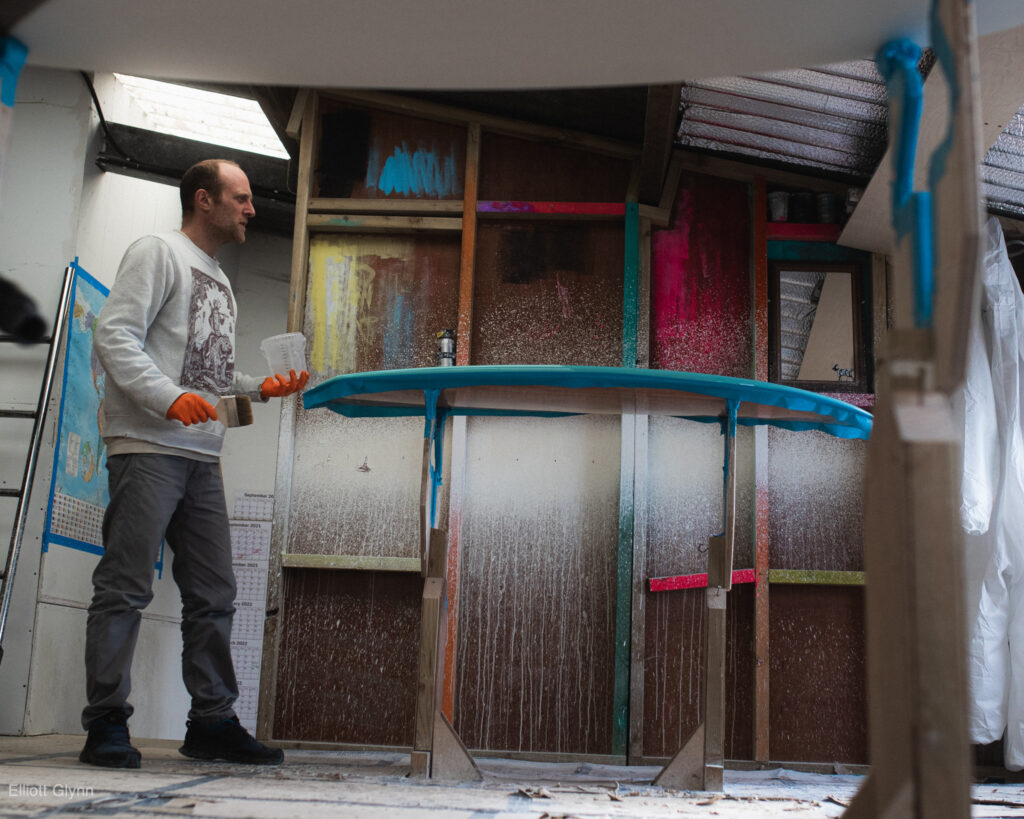
Do you believe consumers will pay more for a board that lasts longer and is close to the performance of a traditional PU board?
The boards will be much better in every way, so yes, they will. It’s a more expensive process. Besides, people who care and/or are aware already do, and more will follow. Proper working ‘eco’ boards are still in their infancy, though and certainly not easily obtainable at the moment. But they will be better if and when more manufacturers figure it out. I don’t know if a big brand is making one yet. I haven’t seen one. It might sound a bit silly, but these new working eco boards will all have to scale-up manufacturing at some point and produce larger amounts. Sustainable scalability is key. But demand will change for sure when people see what’s possible.
We can now control flex, spring, weight and pretty much everything. The possibilities will become limited only by imagination, and in time, all boards will be much more expensive, just like everything. Sorry, but the revolution is upon us, and everyone needs to be paid a fair wage. This will mean much higher quality products. Built to last. Even car manufacturers are using natural fibres and looking like making cars capable of 1 million plus miles. Why not the million-wave surfboard made with natural fibres? There is still a big ‘epoxy/PU’ divide between surfers themselves, where people argue that they just prefer the feel of an ‘old pu board’ when they are often just comparing to epoxy pop-outs and some of the earlier ‘solid or fold in half attempts’. The truth is, most people actually wouldn’t be able to tell the difference in a board glassed with epoxy or PU, when they are both well made.
A lot of the epoxy boards that have hit the market aren’t the best. In the past, board builders have mainly used epoxy to make boards as bombproof as possible or as light as possible. The bombproof is great if you are just starting out and/or messing around and just want a solid board to last and throw around, and the lightest, most performance options are awesome if you want a single-use competition board to fold in half on your second surf and ride less waves than a polystyrene bodyboard! These boards can also be glassed so lightly sometimes that you can feel them crushing in your hands when you duck dive. So at the moment, most manufacturers are using epoxy in the wrong way, one way or another. But that will change for sure.
And what are you most excited about in the future of manufacturing? Or your personal journey?
I guess the main thing I’m excited about are the ideas and designs we and other shapers and manufacturers will come up with. While all these awesome new materials become more easily available to us and new ones get invented. Our intention is to use our surfboards as a platform to show off our new sustainable methods and ways of using natural materials to then go and help other industries find better solutions for their products. We think surfing should pave the way for new, greener technologies. We have been behind forever. Let’s get ahead. It’s time to practise what we preach as surfers and help toward a greener, healthier future for everyone.
As far as my personal journey goes. I haven’t and don’t really think about things like that. I just do stuff. Some of it works. Some doesn’t. I pretty much only show people the stuff that does. Although, as I’ve got older, stuff works more often. It’s already been an incredible journey so far and I’ve met some amazing people along the way who follow the same mindset of necessary change. The time we will all get to work and play together is an exciting prospect to look forward to more of. I’m excited because I do believe that change is coming. People are waking up and figuring out we can carry on living our normal lives but do so in a more sustainable way. There are still non-believers out there. People who think we don’t have to do anything and should just keep consuming. They don’t want to admit that what they are doing is causing damage for fear of not being able to do it anymore. Maybe they are right. Maybe it is all bullshit, and we just end up creating a cleaner, better world for nothing?!
You can catch Predn at the Blue Earth Summit, happening in Bristol on Oct 11 to 13. Grab a ticket here.
